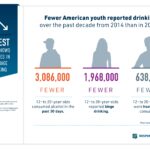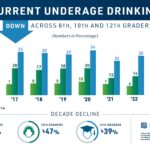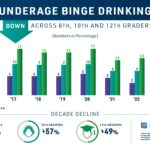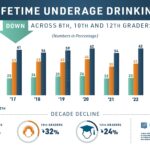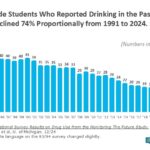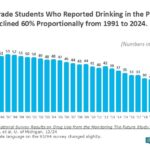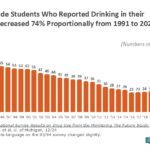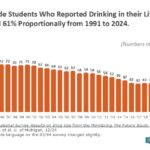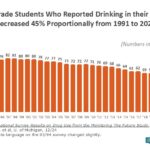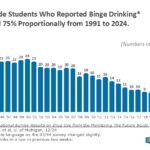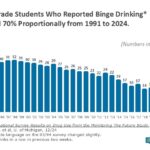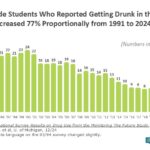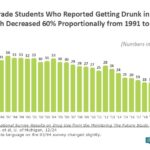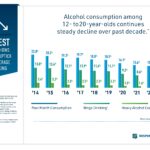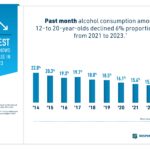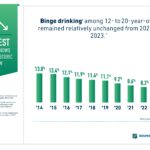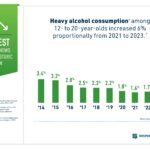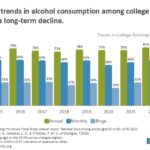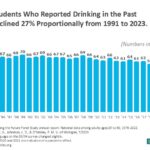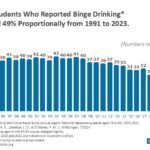Though progress is being made, underage drinking remains a persistent problem. According to the 2023 National Survey on Drug Use and Health (NSDUH) report, about 5.6 million Americans between the ages of 12 and 20 report current alcohol consumption; this represents nearly 15% of this age group for whom alcohol consumption is illegal. Between 2021 and 2023 the survey noted declines in the prevalence rates of alcohol consumption among 12- to 20-year-olds, including reaching historic low levels in 2023 of lifetime, annual, and past month consumption. While underage drinking rates decreased, these declines were not statistically significant year over year, however, they represent a continuation of a steady and long-term decline. There were no significant differences in the estimates of binge drinking and heavy alcohol consumption among 12- to 20-year olds.
Early drinking is a risk factor for alcohol use disorders. Adults who had taken their first drink of alcohol before the age of 15 were 6.5 times more likely to experience an alcohol use disorder than those who didn’t start drinking before age 21. (SAMHSA, 2017 NSDUH).
After declining significantly during the COVID-19 pandemic, substance use among American youth has continued to hold steady at lowered levels for the fourth year in a row, including record low levels in underage drinking. These prevalence rates continue to be significant in that they demonstrate the potential lifetime reduction in substance use by delaying the onset of alcohol and other substances by a single year.
The 2024 Monitoring the Future study found the prevalence of alcohol consumption among America’s youth continued a long-term decline that has taken place over the past two decades. For the three grades combined (8th, 10th, and 12th) the proportion of students reporting lifetime, annual, current (past 30-days), and binge drinking (33 percent, 27 percent, 13 percent, and 5 percent, respectively) decreased in 2024, reaching historic low levels and below pre-pandemic rates.
Underage Drinking–National Survey Results
College Drinking-National Survey Results
Gender Differences in Alcohol Consumption
Where Youth Get their Alcohol
Underage Drinking – National Statistics
For more than 30 years the Foundation for Advancing Alcohol Responsibility has been leading the fight to eliminate drunk driving and underage drinking. While rates have declined, alcohol consumption among youth under the legal drinking age remains a concern.
The rate of current alcohol consumption increases with increasing age according to the 2023 National Survey on Drug Use and Health from 1.2% among 12-13 year olds to 6% among 14-15 years to 13% at ages 16-17, and more than doubling among 18-20 year olds (31%).
Monitoring the Future
The majority of American teens do not drink alcohol, and the long-term declines noted over the past few decades continued in 2024. As noted in the 2024 Monitoring the Future survey, lifetime, annual, past month consumption, and binge drinking levels are below pre-pandemic levels and at historic low levels – 67 percent of American teens report they have never consumed alcohol in their lifetime. Peer disapproval of binge drinking remains high among 8th, 10th, and 12th graders in 2024.
An unintended but positive consequence of the COVID-19 pandemic was unprecedented declines in underage alcohol consumption among American teens. In 2024, the noted decreases in the prevalence of alcohol consumption among youth continued a long-term decline that has taken place over the past two decades and is significantly lower than peak years recorded in the early to mid-1990s, when tracking this data began. From 2000 to 2024 past year consumption alone has decreased 42 percent proportionally, from 73% to 42% among high school seniors, 60 percent proportionally, from 65% to 26% among 10th graders, and 70 percent proportionally, from 43% to 13% among 8th graders.
One in eight teens (14%) report consuming alcohol in the past 30 days. Current alcohol consumption among students in all three grade levels combined reached an historic low in 2024, having declined 43 percent since 2015 and 69 percent since 1991. At the individual grade levels, past month consumption remained relatively unchanged among 8th and 12th grade students between 2023 and 2024 but declined significantly among 10th grade students.
- Past month consumption among eighth graders continues to decline steadily, reaching a record low five percent, decreasing 49 percent over the past ten years.
- Eleven percent of 10th graders report current alcohol consumption, declining 47 percent from 22 percent in 2015.
- Slightly more than one in five 12th graders report consuming alcohol in the past 30 days. Current drinking among high seniors is down 39 percent over the past decade from 35 percent in 2015 to 22 percent in 2024.
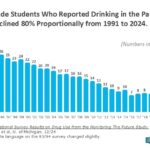
Past month consumption among 8th graders continues to experience modest by steady long-term declines. Five percent report current alcohol consumption, down 49% over the past decade.
Among teens in grades 8, 10, and 12 combined, the majority (67 percent) report they have never consumed alcohol in their lifetime. Over the past decade, the number of combined students reporting they have consumed alcohol decreased 27 percent, proportionally, and 59 percent from a record high of 80 percent in 1991. More than eight out of ten (82 percent) 8th graders report they have never consumed alcohol, with almost 19 percent reporting they have consumed alcohol at least once in their lifetime. Lifetime consumption among eighth graders is down 74% proportionally from 70% in 1991. Lifetime consumption of alcohol declined significantly among tenth graders and twelfth graders from 2023 to 2024. Sixty-eight percent of 10th graders have never consumed alcohol in their lifetime, a decrease of 61 percent, proportionally, from 1991, and 32 percent since 2015. Additionally, 51% of high school seniors report they have never consumed alcohol, down 45 percent, proportionally, from a high of 88 percent in 1991, and declining 24 percent over the past ten years.
In 2024, annual consumption rates remained relatively unchanged among 8th grade students but declined significantly among 10th and 12th grade students. Among all three grade levels combined, the prevalence rate of past year consumption decreased a significant 3.4 percentage points from 30.0% in 2023 to 26.6% in 2024. At the individual grade level, annual consumption was at new historic low levels – 13% among 8th graders, 26% among 10th graders, and 42% among 12th graders – declining 76% proportionally among 8th graders, 64% among 10th graders, and 46% among 12th graders since record-keeping began in 1991. From 2023 to 2024, annual alcohol consumption among 10th and 12th graders decreased significantly, 4.6 and 4.0 percentage points, respectively.
- Thirteen percent of eighth graders report consuming alcohol in the past year, down 39% proportionally from 20% in 2015.
- Tenth graders’ reported annual consumption rate decreased significantly from 2023, reaching a record low level. Twenty-six percent of 10th graders report consuming alcohol in the past year, a decrease of 38% proportionally from 42% in 2015.
- The prevalence rate of past year consumption among high school seniors has declined 31% proportionally from 58% in 2015 to 42% in 2024.
Overall substance use among teens in 2024 remained below the pre-pandemic levels reported in 2020. Underage binge drinking (defined as having five or more drinks in a row in the past two weeks) continued to its long-term decline reaching record low levels. Among 8th, 10th and 12th graders combined binge drinking declined, with only one in 20 reporting they have engaged in this level of harmful consumption. Binge drinking has declined 53 percent proportionally from 2015 to 2024 and 75 percent since 1991.
- Less than two percent of 8th graders reported binge drinking in 2024, a decrease of 84 percent from 1991, and 63 percent from 2015 to 2024.
- Five percent of 10th graders engaged in binge drinking, down 57 percent from 11 percent in 2015, and 75 percent since 1991.
- One in 11 high school seniors (9 percent) report consuming five or more drinks in a row, a 49 percent decrease from 17 percent, proportionally, in 2015, and 70 percent from 1991 to 2024.
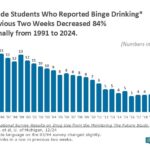
82% of 8th graders disapprove of binge drinking. Given this high level of peer disapproval it is not surprising that less than 2% of 8th graders reported binge drinking, down 63% since 2015.
According to the 2024 Monitoring the Future study the proportion of students reporting they have been drunk in the past 30 days reached an all-time record low. The long-term trend of American teens reporting they have been drunk in the past month has continued to decline – since 1991 the rate among students in all three grades combined is down 69% proportionally from 19% in 1991 to 6% in 2024, and down 44% over the past decade down from 1% in 2015.
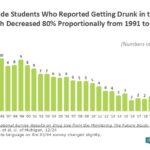
Less than 2% of 8th graders report having been drunk in the past month. Eighth grade students who reported getting drunk in the past 30 days decreased 52% over the past decade, and 80% since 1991.
(Source: NIDA, National Survey Results on Drug Use from 2024 Monitoring the Future Study, 12/2024)
National Survey on Drug Use and Health
According to the 2023 National Survey on Drug Use and Health (NSDUH), an estimated 5.6 million Americans between the ages of 12 and 20 report current alcohol consumption; this represents nearly 15% of this age group for whom alcohol consumption is illegal.
For more than three decades the Substance Abuse and Mental Health Services Administration (SAMHSA) has collected data to advance the behavioral health of Americans, reporting on key substance use and mental health indicators. From 2021 to 2023 the National Survey on Drug Use and Health surveys have shown a slight declines in the prevalence rates of lifetime, annual, and current underage drinking, while binge drinking and heavy alcohol consumption relatively unchanged. Among 12- to 20-year olds, there 3.0 million fewer underage drinkers and nearly 2.0 million fewer binge drinkers since 2014.
- Past month consumption among 12- to 20-year-olds declined six percent proportionally from 15.6% in 2021 to 14.6% in 2023. Current consumption among underage persons is at an all-time record low.
- Underage binge drinking rates (four/five or more drinks on the same occasion on at least one day in the past month) remained flat and unchanged from 2021 to 2023 (8.6%).
- Rates of heavy drinking (five or more drinks on the same occasion on 5 or more days in the past 30 days) increased, but not significantly, among 12- to 20-year-olds during this time from 1.6% in 2021 to 1.7% in 2023. (Source: SAMHSA, 2022 Na3ional Survey on Drug Use and Health, 7/2024)
College Drinking – National Survey Results
According to the 2024 Monitoring the Future Panel Study, in 2023 there were no significant difference in the prevalence rates of alcohol consumption among college and non-college young adults. Alcohol consumption among college students has continued a gradual long-term over the past decade making significant declines in 2023. Alcohol prevalence rates declined in 2023 reaching new record low levels of past 30-day and binge drinking.
Overall, the prevalence of college drinking over the past 30 years, measured as annual, and past 30-day consumption rates continues to trend downward. Since 1991, annual consumption among college students declined 15% proportionally, monthly consumption has declined 27%
proportionately, and binge drinking declined 49%.
In 2023, one in four college students (25%) report they did not consume alcohol in the past 12 months, and 45 percent report they did not drink alcohol in the past 30-days. Rates of binge drinking among college students decreased significantly from 2022 to 2023, reaching a new historic low level in binge drinking.
- In 2023, more than one in five college students report binge drinking (having five or more drinks in a row in the past two weeks). However, the prevalence of binge drinking among college students declined significantly – 21 percent proportionally – from 27.7 percent in 2022 to 21.9 percent in 2023.
- Over the past ten years there have been significant decreases in binge drinking among college men and college women. In 2023, binge drinking rates among college men reached the lowest record level since record-keeping began in 1980 at 24.4 percent. Among college women binge drinking (19.9 percent) decreased significantly from 2022 to 2023.
- Binge drinking had typically been more prevalent among college than noncollege young adults over the years, but in 2023 there was no significant difference.
- High-intensity drinking (consuming 10 or more drinks in a row at least once in the past two weeks) declined significantly from 2021 to 2022. In 2023, one in 20 college students (5.1 percent) said they consumed 10 or more drinks in a row consistent with 5.2 percent in 2022.
- College men were 2.6 times more likely to report having engaged in high-intensity drinking than their college women peers (7.9% and 3.0%, respectively).
(Source: University of Michigan, Monitoring the Future Panel Study annual report: National data on substance use among adults ages 19 to 60, 1976-2023, 7/2024)
Gender Differences in Alcohol Consumption
According to the 2023 National Survey on Drug Use and Health (NSDUH), nearly 5.5 million 12- fo 20-year old girls reported consuming alcohol in the past year.
In 2023, females aged 12 to 20 reported higher rates on alcohol consumption on prevalence rates than their male peers – lifetime (35.3% females vs. 31.1% males, respectively), past year consumption (29.8% females v. 26.0% males), past month alcohol consumption, (15.6% females v. 13.7% males), binge drinking (9.2% females v. 8.1% males), and heavy alcohol consumption (1.9% females vs. 1.6% males). Similar to their older peers, 12- to 17-year old females report higher rates of underage drinking – past year drinking, current alcohol consumption, and binge drinking compared to their male peers in 2022. While heavy alcohol consumption rates remain low among both males and females (0.5% males and 0.6% females) it did increase from 0.2% among both in 2022. There were no statistically significant changes noted in the gender gaps in alcohol consumption from 2022 to 2023 among 12- to 20-year olds and 12- to 17-year olds, however, even the slight increases noted in harmful drinking rates remains a concern. (Source: SAMHSA, 2023 National Survey on Drug Use and Health, 7/2024)
The 2024 Monitoring the Future Panel Study reports among college students in 2023 there was no significant differences in alcohol consumption – annual or monthly – between college men and college women. Current rates of alcohol consumption among college women decreased significantly from 2022 to 2023 – down 11 percent proportionally – but remains slightly albeit not significantly higher among college men (58% and 51%, respectively). While consumption trends have been relatively unchanged for college women over the past decade, they have significantly declined among college men (63% in 2013 to 51% in 2023).
There were no significant differences in alcohol consumption measured on the prevalence rates of 12-month, 30-day or harmful binge drinking (defined as having consumed five or more drinks in a row during the previous two weeks) among college young adults compared to their non-college age peers. Three out of four college students and non-college young adults consumed alcohol in the past year (75% and 73%, respectively), while slightly more than half report drinking in the past month (55% and 52%, respectively).
College young adults and their non-college peers had similar rates of binge drinking (22% vs. 20%) as well as high-intensity drinking (10+ drinks in a row) in the past two weeks (5.1% vs. 8.4%).
Rates of extreme binge drinking (10 or more drinks) indicate a significantly larger variance by gender in 2023 with more than two times the number of college men reporting they participated in this level of extreme drinking compared to college women.
- College men were 2.6 times more likely than college women to self-report having engaged in high intensity drinking, that is, having 10 or more drinks in a row in the past two weeks (8% and 3%, respectively).
- Non-college age young adults were slightly, but not significantly, more likely than their college-age peers to engage in high intensity. Non-college men were significantly more likely to report consuming 10 or more drinks in a row in the last two weeks than their women peers (13% and 2%, respectively).
(Source: University of Michigan, Monitoring the Future Panel Study annual report: National data on substance use among adults ages 19 to 60, 1976-2023, 7/2024)
Where Youth Get Their Alcohol
According to the 2023 National Survey on Drug Use and Health (NSDUH) nearly half of current underage drinkers ages 12 to 20, who consumed alcohol in the past month, report the last time they drank alcohol it was either at their own home (45%) or in someone else’s house (41%). Additionally, seven out of ten of these underage drinkers report they were drinking with more than one other person the last time they drank.
Family and friends continue to be a leading source of alcohol for today’s youth. Seventy-four percent of current underage drinkers said they did not pay for the alcohol they consumed the last time they drank. The most frequently cited source of alcohol for current underage drinkers was an unrelated person aged 21 or older (25%), followed by family and friends. More specifically, their own parents/guardian (17%), another adult family member 21 or older (18%), another underage person (16%), took it from own home (10%), and took from someone else’s home (3%).
Regardless of the source of alcohol, youth report access to alcohol is easy. According to the 2023 Monitoring the Future survey 82% of 12th graders, 59% of 10th graders, and 41% of 8th graders say it be “fairly easy” or “very easy” for them to get alcohol. On a positive note, despite reported ease of obtaining alcohol disapproval of binge drinking continues to remain high among all three grade levels (8th, 80%; 10th, 80%; 12th, 66%).
Influence of Parents
Despite being identified by youth as one of their primary sources of alcohol, hands down, parents are the most influential person or thing in a child’s decision not to drink at all or not to drink on occasion. In a 2023 survey of parents and their kids, 1 in 3 youth reported their parents as the leading influence on their decision to drink or not.
